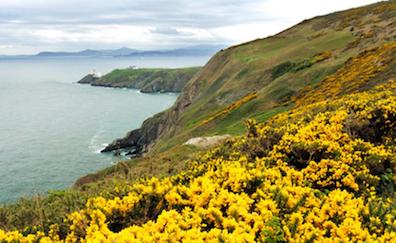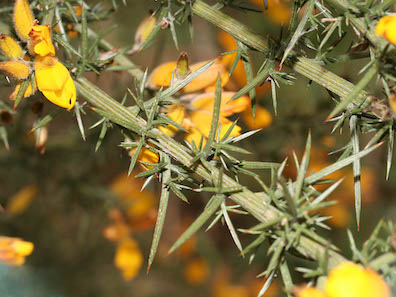The paleolithic "hero" described near the beginning of Cyclops
is covered "with a strong growth of tawny prickly hair in hue
and toughness similar to the mountain gorse (Ulex Europeus)."
This plant, evoked again several times in later chapters, is
an evergreen shrub covered with long green photosynthetic
thorns and with shorter leaves that, rather than unfurling,
form additional spines. Its "prickly" quality and "toughness"
are extreme. The bush is also called "furze," and makes some
appearances in the novel under that name. (There is still
another common name, "whin," which Seamus Heaney uses in his
excellent early poem "Whinlands.")
The Ulex genus comprises 20 species scattered across
northwest Africa, the Iberian peninsula, and other parts of
Europe. The most common one in Europe, Ulex europaeus,
grows to 2 or 3 meters in height (7-10 feet). Like all members
of the genus it sports beautiful yellow flowers, but its
resistance to drought, fire, and animals makes it an invasive
pest in many settings. Because of its thorny toughness it has
often been planted in hedgerows, where it forms impenetrable
thickets. It also grows wild in many parts of Ireland, and
once was important for thatching roofs and burning in
fireplaces.
Gorse is adapted to recurrent fire. As Heaney observes, it
ignites readily but fire "Only takes the thorn. / The tough
sticks don't burn." The plant will also grow back from its
roots, and scorching prompts its seeds to germinate.
In
Nausicaa Bloom
thinks of fires starting in the hills: "Howth a while ago
amethyst. Glass flashing. That’s how that wise man what’s his
name with the burning glass.
Then the heather goes on fire.
It can’t be tourists’ matches. What? Perhaps the sticks dry rub
together in the wind and light.
Or broken bottles in the
furze act as a burning glass in the sun."
The toughness of the plant figures repeatedly in
Circe.
A verse of
The Wren Song tells of the little bird "
caught
in the furze." Bello uses it to convey the fearsome
virility of Boylan: "
A shock of red hair he has sticking out
of him behind like a furzebush!" And Bloom's schoolday
memories of the forest at Poulaphouca give way to images of him
walking on Howth Head with Molly, "
Hatless, flushed,
covered with burrs of thistledown and gorsespine."
§ This
last word did not appear in any printed text until Hans Walter
Gabler's 1984 edition. The "gorsepine" of the
first edition, although it was not corrected in any of the
Odyssey Press editions of the 1930s and stayed unchanged in
the Bodley Head and Modern Library editions of the early
1960s, can hardly be supposed to represent Joyce's intention.
The Rosenbach manuscript clearly contains an "s" between
"gorse" and "pine" on page 55 of Circe, and no pine
trees anywhere in the world are called gorse-pines, to my
knowledge. Even if such trees existed it is hard to imagine
how Bloom would get burrs from them in his clothes from
tramping around the Howth headland. Gorse-spines, on
the other hand, can easily mess with hikers' clothes.


